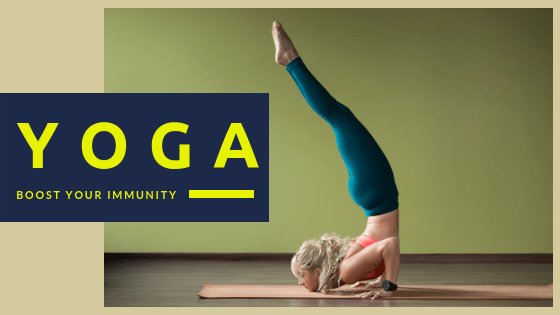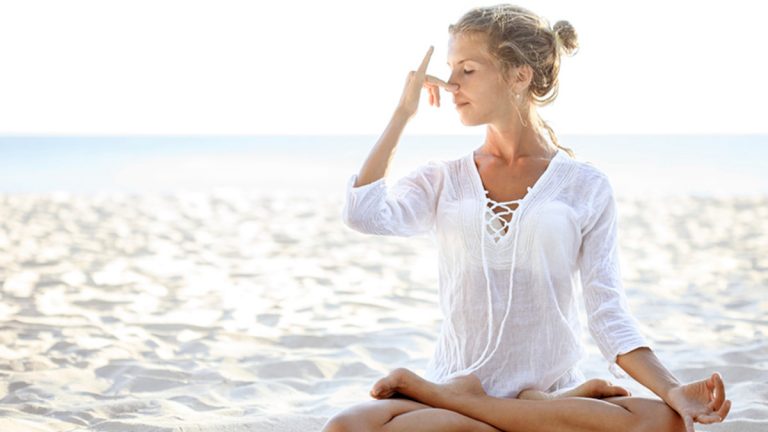Yoga is an ancient form of practice and is a proven way to improve the overall physical and mental wellbeing of any individual if practiced in the right way. Yoga helps in the overall regulation of hormones, improves blood circulation, reduces stress and nourishes all the internal organs which help in their proper functioning, thus improving the functioning of the immune system.
Here are 5 asanas which help in improving the functioning of the immune system
Sukhasana
This is the most important pose for meditation, which helps the prana or the vital force to move throughout your body. This asana allows you to breathe deeply which helps to reduce stress, regulates the hormones, heart rate and nervous system distress which helps improve the immune system.
Caution: If you any issues related to the knee or if you are unable to sit down, you can sit on a chair and keep your foot on the floor.
Steps to follow:
- Sit in a comfortable position with folded legs. Keep your back straight.
- Keep your fingers in chin mudra on your lap. Close your eyes.
- Take a deep breath, hold for as long as you can and exhale slowly.
- Repeat this process 10 times.
Matsyasana
Also called fish pose, traditionally done using padmasana, it has a variation in which you can keep your legs straight in front of you. You can choose which is comfortable for you. This asana is very helpful to relieve the stress and it also has a good effect on the lungs which can help to relieve congestion.
Caution: If you have any problems or pain while doing the asana, stop immediately and consult a yoga practitioner for further advice on how to practice. Please avoid doing this asana if you have high blood pressure or any problems related to the spine or neck.
Steps to follow:
- Lay down in Shavasana (laying down flat on your back with hands kept away from your body and legs apart).
- Slowly bring your legs closer, keep your legs straight together in front of you with toes pointing forward.
- Slowly with the support of your hands, bend your neck backward such that the mid-region of your head touches the floor (as shown in the picture).
- Your back should be bent like a bow.
- Slowly bring your hands forward and keep it on your abdomen. Your head should remain in the same position.
- Breath normally once you are in this position.
- Stay in this position for a few seconds and then slowly lower your head with the support of your hand bring your hands and legs in the comfortable position of Shavasana.
- You can repeat for a maximum of two or three times.
ArdhaMatsyendrasana
This asana helps decompress and nourish the spine. It also helps in improving the functioning of the internal organs around the abdomen region thus improving the immune system.
Caution: if you have any issues related to the spine or neck muscles, you can look to the side instead of turning your neck backward.
Steps to follow:
- Sit in a comfortable position with legs straight out in front of you.
- Slowly place your right leg on the outside of the left leg so that your right foot is on the ground. You can cross your left leg under your right leg (the foot being closer to the hip).
- On an inhale put your right hand back and exhale slowly, twist the upper part of your body towards the right side and try to look back as much as possible.
- Keep your left hand on the outside of the right knee.
- Inhale and exhale normally. Remain for a few minutes in this position.
- Repeat on the opposite side.
Trikonasana
This pose is so-called because the pose looks like a triangle. This asana helps in stretching all the muscles in the body. It aids in improving digestion, reduces blood pressure, improves blood circulation, concentration and balance thus helps in keeping the mind calm. It also nourishes the organs in the upper part of the body thus improving the immune system.
Steps to follow:
- Stand straight with legs kept at a maximum distance apart.
- Bend forward from the hip. Ensure your waist is straight.
- Take a deep breath, exhale and twist your body to the right and bring your right palm down and move your left arm upward such that it is in line with your shoulder.
- Depending on your comfort level keep your right palm on the ankle, shin or the floor.
- Your body should be bent sideways and your chest and pelvis should be wide open.
Tadasana
It is the basic pose for all the other asanas. So it is called the mother of all poses. This asana helps improve balance and regulates the digestive system. It also helps in regulating the breath control, increases awareness, improves blood circulation and relieves tension. It also increases energy in the body, keeps you refreshed, regulates the hormones and thus improves the immune system in the body.
Remember not to strain your abdominal muscles or any other muscle in the body while practicing this asana.
Steps to follow:
- Stand straight with your foot close together or you can keep it a little apart.
- Make your thigh muscles and calf muscles firm. Slowly breathe in and raise your body upward standing on your toe.
- While standing on your toe, raise your arms, stretch your arms straight up above your shoulders and intertwine your fingers. Also stretch your chest and shoulders.
- Stand in this position for a few seconds and breathe normally. Try to focus on one point in front of you.
- Slowly exhale and bring your arms, foot and your body down. Relax
Sethubadhasana
Also called as the bridge pose is an important asana which helps in strenghthening the back muscles and stretches the chest, neck muscles and the spine. It regulates high blood pressure, helps to reduce symptoms of asthma, sinusitis and osteoporosis. It keeps your mind calm which helps in reducing anxiety, stress, and depression. Mainly it helps open up the lungs and reduces thyroid problems. It helps in improving digestion and also helps in improving the immune system.
Steps to follow:
- Lay down in Shavasana (relaxing pose).
- Slowly keep your legs close together straight in front of you.
- Bend your knees and keep your feet hip distance apart on the floor. Keep your foot as close as possible to your hip.
- Keep your palms beside your body with palms facing down.
- Slowly inhale and lift your lower back, middle back and upper back off the floor. Gently roll in your shoulders, touch the chest to the chin without bringing the chin down.
- Support your body weight with your shoulder, arms and your feet.
- Both your legs should be parallel to the ground.
- Once you are in the position, breath normally.
- Hold the posture for few minutes and then slowly exhale and release the pose. Relax in Shavasana.
Dhanurasana
Also called as bow pose, this asana helps strengthen the back and abdominal muscles, opens up chest, neck and shoulders and stimulates reproductive organs. It helps relieve stress and fatigue, gives greater flexibility to the back and also helps people with renal disorders. It is one of the important asanas that help in improving the immune system.
Steps to follow:
- Lie on your stomach with your feet hip-width apart and keep your arms at the side of the body.
- Fold your knees, take your hands backwards and hold your respective ankle.
- Inhale, lift your chest off the ground and pull your legs up and try to push your legs backward.
- Look straight ahead. Continue to take deep breath and relax in this pose. Do not overdo the stretch. Bend your body as much as possible.
- Stay in posture for few seconds, exhale and then gently bring your legs and hands down. Relax.
Yogasana is a practice that has to be done slowly and in a rhythm. Never try to do any asana in a hurry. Remember it is very important to follow the steps in the right way. If you are a beginner or if you have any other issues related to your health, consult a Yoga practitioner before starting to practice. Any Yogasana has to be performed in an empty stomach, or after 4 hours of having food which will give you good results. Also it has to be practiced consistently (at least 3 days in a week) if you want to see your health improve.
To know more about how Ayurveda helps to boost your Immunity system, refer “How to boost your Immune System with Ayurveda?”



